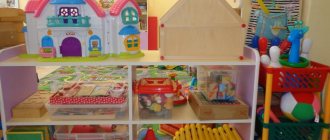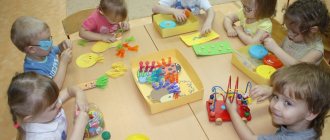The relevance of building a subject-development environment in preschool educational institutions in accordance with the State Standards
The relevance of constructing a subject-developmental
environment in the preschool educational institution in accordance with the State Standards
Andreeva T.V.,
senior teacher of preschool educational institution No. 166
The issue of organizing a subject-developmental environment in preschool educational institutions is particularly relevant today. In connection with the introduction of the State educational standard for preschool education for 2015-2017. requirements were developed for the conditions for the implementation of the Model Program, including requirements for the subject-development environment (p. III, clause 3.3). Why are such high demands placed on the development environment of preschool educational institutions? The answer to this question is connected, first of all, with the specifics of preschool age, with those features in which a preschooler differs from older subjects of education. The source of knowledge, social experience and development of a preschool child is his environment. Therefore, it is very important that this environment is developmental. All children, as we know, are different, and each preschooler has the right to his own path of development, therefore, in order to realize the individual interests, inclinations and needs of preschoolers, the subject-development environment must provide each child with the right and freedom to choose an activity.
Targets for completing preschool education are clearly outlined in the Model Program “From Birth to School”. The child must have initiative and independence in various types of activities, the ability to choose occupations and partners, the ability to generate and implement various ideas, self-confidence and openness to the outside world. Therefore, a developing subject-spatial environment that stimulates the child’s communicative, playful, cognitive, physical and other types of activity must be organized in accordance with the age-specific specifics of his development.
Organization of a developing subject-spatial environment in a preschool educational institution with
taking into account the State Educational Standard is structured in such a way as to enable the most
effectively develop the individuality of each child, his inclinations,
interests, level of activity.
The developing subject-spatial environment is organized so that
every child had the opportunity to freely do what they loved.
Rich developmental subject - spatial and educational
the environment becomes the basis for organizing an exciting, meaningful
life and diversified development of every child. The developing subject environment is the main means of personality formation
child and is the source of his knowledge and social experience.
I would like to draw your attention to the fact that research into the subject environment has been going on for a long time. The environment as a multicomponent phenomenon is a subject of study by philosophers, educators, philosophers, ecologists, psychologists, and other specialists. From the standpoint of the psychological context, according to L. S. Vygodsky, P. Ya. Galperin, V. V. Davydov, L. V. Zankov, A. N. Leontyev, D. B. Elkonin and others, the developmental environment is a certain ordered educational space in which developmental learning is carried out.
The famous French teacher Celestin Frenet believed that thanks to the environment, the child himself can develop his individual abilities and capabilities. The role of an adult is to correctly model an environment that promotes maximum development of the child’s personality.
The very concept of a subject-based developmental environment was introduced into the lexicon of teachers and designers after 1988, when the Concept of Preschool Education was published; research in this area began much earlier. With the release of a standard project for the construction of kindergartens (1932), the question of group equipment and the organization of children’s living space (“corners”, “zones”) was raised. The scientific development of object-based play equipment began with the opening of the Research Institute of Preschool Education (1960). S. L. Novoselova and N. N. made a great contribution to the creation of a system of educational toys and teaching aids. Poddyakov (1968). By the mid-70s, principles for the formation of a subject environment were developed: a new pedagogical classification of toys was proposed, educational modular game environments, construction sets, and a system of educational toys for young children were developed (G.G. Lokutsievskaya, N.N. Poddyakov, L.A. Paramonova, S.L. Novoselova, N.T. Grinyavichina, E. V. Zvorygina, etc.). In the second half of the 80s, the concept and operating system of “computer gaming complex” (CGC) was developed, under the scientific leadership of N.N. Poddyakova, S.L. Novoselova, L.A. Paramonova. In the 90s, the question of enriching the subject-development environment was raised in the works of V.A. Petrovsky,
Most experts use the concept of Doctor of Psychological Sciences S.L. Novoselova: “A developing subject environment is a system of material objects of a child’s activity that functionally modernizes the content of the development of his spiritual and physical appearance. An enriched developmental environment presupposes the unity of social and natural means of ensuring a child’s varied activities.”
All children, as we know, are different, and each preschooler has the right to his own path of development, therefore, in order to realize the individual interests, inclinations and needs of preschoolers, the subject-development environment must provide each child with the right and freedom to choose an activity. However, the environment in groups often does not correspond to the interests of children and does not encourage them to make independent free choices. The psychological foundations for constructing a developmental, subject-based childhood environment are based on the activity-age system approach and modern ideas about the subject-oriented nature of activity, its development and significance for the mental and personal development of the child. The works of many domestic teachers (G.M. Lyamin, A.P. Usov, E.A. Panko) talk about the need to include preschoolers in meaningful activities, during which they themselves could discover more and more new properties of objects, notice them similarities and differences. In a word, it is necessary to provide children with the opportunity to acquire knowledge on their own.
S.L. Novoselova argues that activity in its development constantly changes its psychological content depending on the subject’s generalization of his experience. Activity builds the psyche. Inactivity, the lack of opportunity to do something, leads to limited opportunities, and subsequently to personality deprivation. The objective world of childhood is the environment for the development of all specific types of activity.
The subject development environment is:
- a system of material objects and means of activity of a child, functionally modeling the content of the development of his spiritual and physical appearance in accordance with the requirements of the basic general educational program of preschool education.
- this is a complex of aesthetic, psychological and pedagogical conditions necessary for the implementation of the pedagogical process, rationally organized in space and time, saturated with a variety of objects and gaming materials.
The environment surrounding children in kindergarten should ensure the safety of their lives, promote health and strengthen the body of each of them. The principle of integration of educational areas contributes to the formation of a unified subject-spatial environment.
This means that for the comprehensive development of the child,
several subject developmental “environments”: for speech, mathematics,
aesthetic, physical development, which, depending on the situation
can be combined into one or more multifunctional environments. At
In this regard, it is very important that the objects and toys that will be used
child, at the first stage of mastering this environment were not just objects
his attention, but a means of communication with adults.
MAGAZINE Preschooler.RF
PROJECT “Creation of a subject-spatial environment in a preschool educational institution in accordance with the Federal State Educational Standards of Preschool Education”Prepared by senior teacher of MBDOU No. 10 I.V. Tishchenko
Objective of the project:
- Development of a model of a subject-spatial environment that promotes the harmonious development and self-development of children in specific group conditions, followed by its formation and bringing it into compliance with the Federal State Educational Standard.
Project objectives:
- Teachers' mastery of new educational technologies and methods of working with children in the use of a subject-spatial environment that helps improve their professional competence.
- Creation of a subject-spatial environment that ensures respect for the personality of each child, developing his self-confidence, initiative, creativity, independence and responsibility, the ability to accept and implement changes, think, set and solve problems, and care for people.
Hypothesis
- If a subject-spatial environment is created in a preschool educational institution that is adequate to the program being implemented, corresponding to the characteristics of the pedagogical process and the Federal State Educational Standard, then all this will effectively contribute to the formation of the basis of personal culture and the development of the individuality of each child.
Project stages
Stage I: Formation of the problem, goals and objectives of the project.
Stage II: Practical implementation of the project.
Stage III: Summing up. Preparation of project materials.
Relevance of the project
The issue of creating a subject-spatial environment for preschool educational institutions is particularly relevant today. This is due to the new Federal State Educational Standards of the structure of the basic general education program of preschool education.
The solution of program educational programs is provided not only in the joint activities of adults and children, but also in independent activities during routine moments.
It is known that the leading activity of preschoolers is play. Therefore, teachers are experiencing increased interest in updating the subject-spatial environment.
The organization of the spatial environment in a preschool educational institution should be structured in such a way as to make it possible to develop the individuality of each child, taking into account his interests and level of activity. It is necessary to enrich the environment with elements that stimulate the cognitive, emotional, and motor activity of children.
The subject-spatial environment should be organized so that every child can do what he loves.
Directions of innovative methodological activities to create a subject-spatial environment.
Improving the quality of teaching activities:
- development of key professional competencies of teachers (communicative, informational, intellectual and pedagogical as basic) in matters of an innovative approach to organizing the subject-spatial environment in a group based on the implementation of the principle of integration of educational areas;
- Preparing teachers to design and summarize the results of work on organizing developmental activity centers for children, taking into account their age and individual characteristics.
Improving the educational process is:
- development and implementation of active methods of education, training and development of children in various forms of educational activities: joint, independent;
- organization of joint design and development activities for preschoolers and adults;
- active inclusion of the family in the organization of the subject-spatial environment of the preschool educational institution;
- development of methods of psychological and pedagogical diagnostics and forecasting in the educational process to assess the influence of the environment on the development of personal, intellectual, physical qualities of children.
Plan of methodological work for the implementation of the project for creating a subject-spatial environment in accordance with the requirements of the Federal State Educational Standard
Working with teachers
Consultation: “Cultivating a culture of behavior in children through a subject-spatial environment” October Art. teacher
Seminar: “Organization of the subject-spatial environment in a preschool educational institution in the conditions of the Federal State Educational Standard” November Head
Art. teacher
Round table: “Features of organizing the subject-spatial environment in different age groups” January Art. teacher
Group teachers
Seminar: “Integrative approach to organizing developmental activity centers for children” February Art. teacher
Monitoring of the developing environment March Art. teacher
Group teachers
Workshop: “Maintaining Activity Centers” . Joining groups April Art. teacher
Group teachers
Organization of exhibitions and competitions
Competition: “Organization of a developmental environment in kindergarten groups” May St. teacher
Group teachers
Planned result for teachers
- Increasing the educational level and qualifications of teachers in matters of an innovative approach to creating a subject-spatial environment.
- The ability to design, present and defend a feasible model for organizing the subject-spatial environment of a group, taking into account the age and individual characteristics of children, the tasks of the basic general education program of preschool education, and the work program.
- Increasing the effectiveness of pedagogical activities in organizing the subject-spatial environment, expressed by educational (intellectual, personal, physical qualities) and personal achievements of children of each age group.
- Generalization of work experience in organizing developmental activity centers for children in a subject-spatial environment on the principles of integration of educational areas of the main general education program of preschool education.
Planned outcome for students
- They actively develop, absorbing information about the world around them during games and other types of children's activities.
- Go through regular stages of development
- Provided with social interaction aimed at emotional and cognitive development
- Everyone develops uniquely and individually at their own pace.
Planned result for preschool educational institution
- Ensuring the spiritual and moral development and education of children
- High quality of preschool education, its accessibility, openness and attractiveness for children and their parents and the whole society
- Protecting and strengthening the physical and mental health of pupils
- Comfortable condition of pupils and teaching staff
| Next > |
Organization of a developing subject-spatial environment during the implementation of project activities
Arzamaskova Anastasia Vladimirovna
Organization of a developing subject-spatial environment during the implementation of project activities
Speech at the RMO
«Organization of a developing subject-spatial environment during the implementation of project activities»
Kurgan region “Lesnikovsky kindergarten No. 2” teacher: Arzamaskova A. V. 2022
Listen and you will forget, watch and you will remember,
do it and you will understand.
Confucius
Working on my topic for several years, I noticed that children, spending most of their time in kindergarten, develop in the process of upbringing and learning, that is, in active, meaningful activities with adults and peers. environment must be created around the child in which he develops sensory skills, accumulates life experience, learns to organize and compare different objects and phenomena , gains experience in emotional and practical interaction with adults and peers, and acquires knowledge from his own experience.
When starting to study this problem, I asked myself the question: “What is the novelty of the topic, its relevance?”
And the fact is that when creating a competently
organized developmental subject-spatial environment , children develop self-confidence , independence, initiative, and creativity are manifested.
I also set myself the following goals and objectives:
Goal: to develop a model of a developing subject-spatial environment that promotes the harmonious development and self-development of children with its subsequent formation and bringing it into compliance with the requirements of the Federal State Educational Standard of Preschool Education.
Tasks:
— To study and put into practice new approaches to organizing a subject-spatial developmental environment that ensures the full development of preschool children within the framework of the educational program of a preschool educational institution, taking into account the requirements of the Federal State Educational Standard for Preschool Education, namely:
— organize a subject-spatial developmental environment that promotes the emotional well-being of children, taking into account their needs and interests;
— create conditions for providing different types of activities for preschoolers ;
— to promote cooperation between children and adults to create a comfortable subject-spatial development environment ;
— to introduce preschoolers to active subject-transformative activities in the interior .
According to the requirements of the Federal State Educational Standard, a developing subject-spatial environment must :
provide the opportunity for communication and joint activities between children and adults .
ensure the implementation of various educational programs.
should be: content-rich, transformable, variable, multifunctional, accessible, safe;
provide opportunities for communication and joint activities between children and adults , as well as opportunities for privacy;
ensure the implementation of the educational program of the educational institution;
take into account national, cultural and climatic conditions;
should be rich, transformable, multifunctional, variable, accessible and safe.
One of the modern promising methods of educating preschool children is the design , which I use in my work.
I believe that a properly organized developmental subject-spatial environment can become one of the important components in organizing a project .
In order to develop project activities, teachers should :
• create problematic situations that initiate children's curiosity and stimulate the desire to explore;
• be attentive to children’s questions that arise in different situations, regularly offer project-based educational situations in response to questions asked by children;
•support children's autonomy: invite children to put forward design solutions ;
• help children plan their activities when fulfilling their plans;
• during the discussion of design solutions proposed by children, support their ideas, focusing on the novelty of each proposed option ;
• help children compare proposed solutions and give reasons for choosing an option.
Taking into account the interest of children, I use changes in the developmental environment as motivation for the project ; Together with the children, we make changes to the group space during the implementation of the project ; we saturate the developing subject-spatial environment with the final products obtained during the project .
Our group has implemented projects dedicated to familiarizing ourselves with seasonal changes in nature.
The motivation for starting the project was the appearance of a tree on the thematic wall, which changed its appearance in accordance with the coming season. In the course of observations, research activities and studying the signs of the season, we supplemented our tree with products of children's activities . There was also a folding folder with trees at different times of the year. Children complement it with decorative elements related to natural changes.
Motivation for the project “Feathered Friends”
was the appearance of a tit bird in the group.
During the project, children consolidated their knowledge of the diversity of wintering birds, their characteristic features and habits, learned how to help their feathered friends in winter, and what kind of food birds like.
We discussed which feeders would last us longer, where it would be best to place them, and how we would secure them so as not to damage the trees. Birds created by children using the appliqué
,
"origami"
.
Every year our kindergarten implements projects dedicated to the Great Victory Day. Through excursions, conversations, reading fiction, and meetings with war children, preschoolers learn about the difficult life in wartime, the difficult lot that befell wartime children.
Veterans showed their medals and orders and said that awards go only to the most courageous people who have accomplished a feat. They shared their memories of how difficult and scary it was during the war, and with what joy they celebrated Victory Day.
The children, in turn, showed the veterans their speed, agility, and skills in a sporting event; together with their parents, they took part in the “Lilac of Victory” event, and decorated the “ Battle Glory”
, selected fiction - stories, poems, proverbs and sayings about the war, the holiday
"May 9"
.
Project “My family is my pride”
began with the appearance of a photograph in my family’s group, and my telling the children about it.
The children also wanted to share their family history, but to do this we needed to expand our understanding of the concept of “family”
.
In the process of developing this project, our group acquired board and printed games on the theme of family, as well as attributes for role-playing games; The card index for finger games was replenished, books with poems, stories and fairy tales about the family appeared in the book corner, coloring books about the family appeared in the creativity center. The result of this project was the appearance of family albums in the group, while looking at them the children talked about their family.
Parents are active participants in each . Together with them we:
— made crafts from natural and waste materials.
- received information, enriched the development environment with attributes , books, games, costumes.
I did the following work:
Methodological literature has been selected.
Information material on issues of working with educators has been collected.
Recommendations have been made for educators of all age groups on the design of subject development zones .
Directions for the development of a subject-development environment .
Didactic games were purchased and made with our own hands, and educational zones for the group .
Working on the problem “ Organization of a developing subject-spatial environment through project activities ,” I identified the possible achievements of children at the stage of completing preschool education.
Children learned to create educational products that can be used in play, leisure, and cognitive activities .
Interest in learning, self-esteem, and ability to plan have increased; communicate on equal terms with adults.
Children have developed such qualities as curiosity and activity. independence;
Interest in learning, self-esteem, and ability to plan have increased.
Children learned to take care of their own and other people's work.
Thus, we can conclude that project activities implemented in kindergarten give children the opportunity to enrich the subject-development environment , and the teacher - to integrate the educational process into the family and society.





